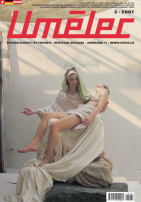|
In the Fifties, Andy Warhol’s technique of massive silkscreen reproductions brought on the collapse of the Avant Garde’s search for an object or theme that would be a subject of artistic interpretation in any and all areas. For Warhol, art did not effect or imitate life; life was an art in itself, a view which bestowed importance on moments and reshaped the experience of everyday life in its entirety. Living in Mexico City, it is inevitable that I think of Warhol every morning, as I find the front pages of newspapers practically slippery with blood, showing an execution or decapitation, or perhaps, as in yesterday’s paper, photographs of a child beaten to death and bitten by his adolescent mother. Violence in art is not a theme that little has been written about; however, as theorists say, it has always been explored from the “obsolete” paradigm of aesthetics. These graphic photos taken by the journalists of this city—do they possess any aesthetic value? And if not, why not? How is it that around the world there are exhibitions of illustrations, paintings and video pieces that portray violence through artifice, yet it is neither artistically, nor politically correct to have an exhibition that celebrates, say, the decades of news photography in “La Prensa,” a model of yellow journalism? In the last few years, this country has undertaken a superfluous search for that which defines our identity. Indeed, we have adopted fashions that try to replicate "indigenous and folk" customs and traditions, but do so by stripping them of their meaning and through recontextualizing them in pricey textile designs or commercialized industries. We try to realize the creation of a market for original national products, all the while exalting our name in stock markets for creating jobs in different and distant communities. All this notwithstanding, it is worthwhile to examine the authenticity of this cultural richness; is this apparent peace and harmony between diverse towns enough to define a country? Would not the violence, corruption and terrible crimes committed by members of government and society be a more truthful identification card? Would it not be more useful to present our own reality as it is, rather than turn to other more cosmopolitan latitudes to disguise ourselves in international style, leaving us laundered of all our natural crudity? The first option could result in an exercise of reflection, possibly with the participation of all citizens, through which we could confront ourselves, from the worst part of our identity, the worst of our reality. Sadly, the benefits that this could bring to artists and galleries cannot be seen, and we continue to delight ourselves in our caramelized society and cultural production— its internationality and its convenient ambiguity.

Recommended articles

|
|
If you know your way around, you might discover that every month and maybe even every week you stand the chance to receive money for your cultural project. Successful applicants have enough money, average applicants have enough to keep their mouths shut, and the unsuccessful ones are kept in check by the chance that they might get lucky in the future. One natural result has been the emergence of…
|

|
|
We’re constantly hearing that someone would like to do some joint project, organize something together, some event, but… damn, how to put it... we really like what you’re doing but it might piss someone off back home. Sure, it’s true that every now and then someone gets kicked out of this institution or that institute for organizing something with Divus, but weren’t they actually terribly self…
|

|
|
Contents of the new issue.
|
|







Comments
There are currently no comments.Add new comment